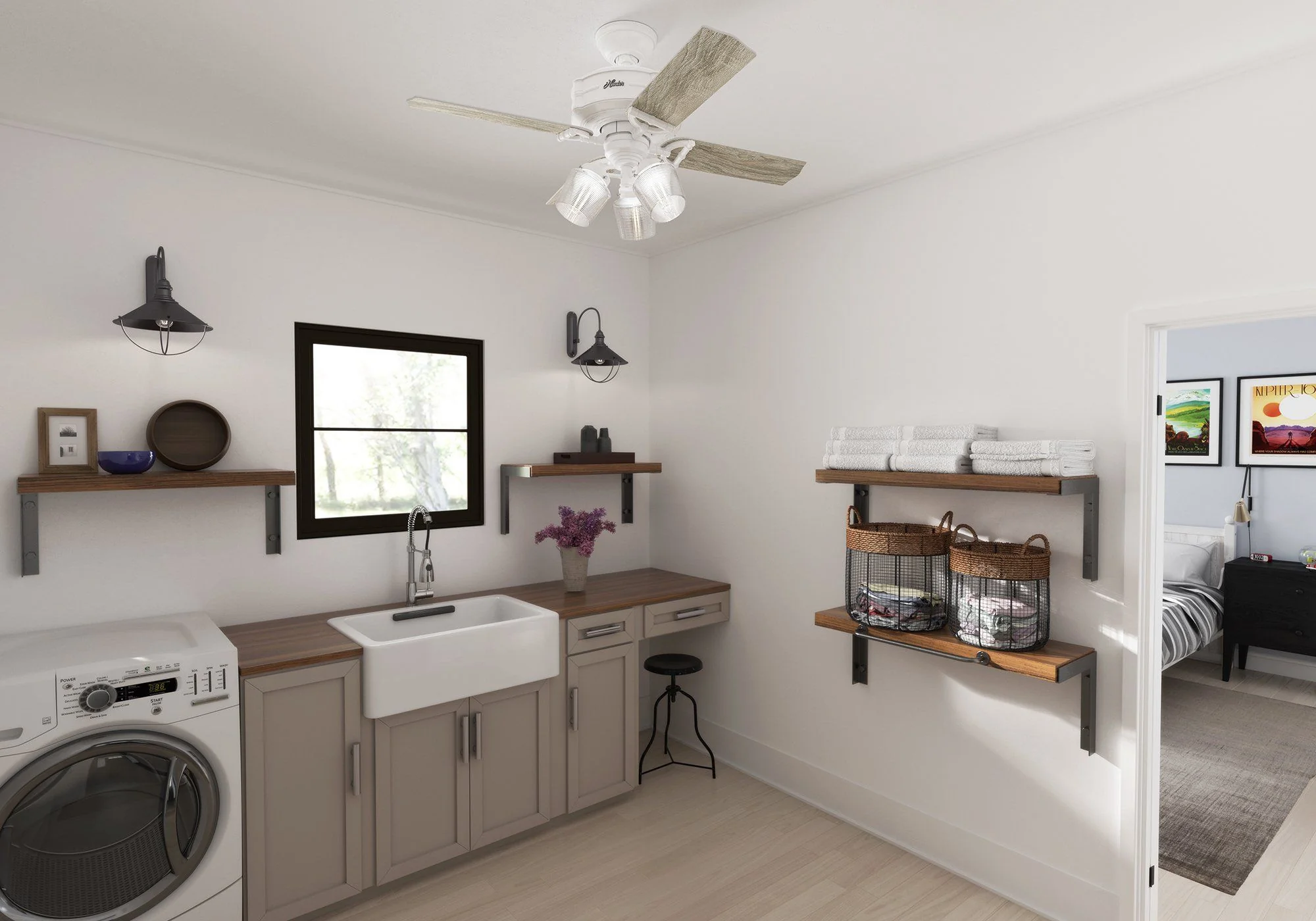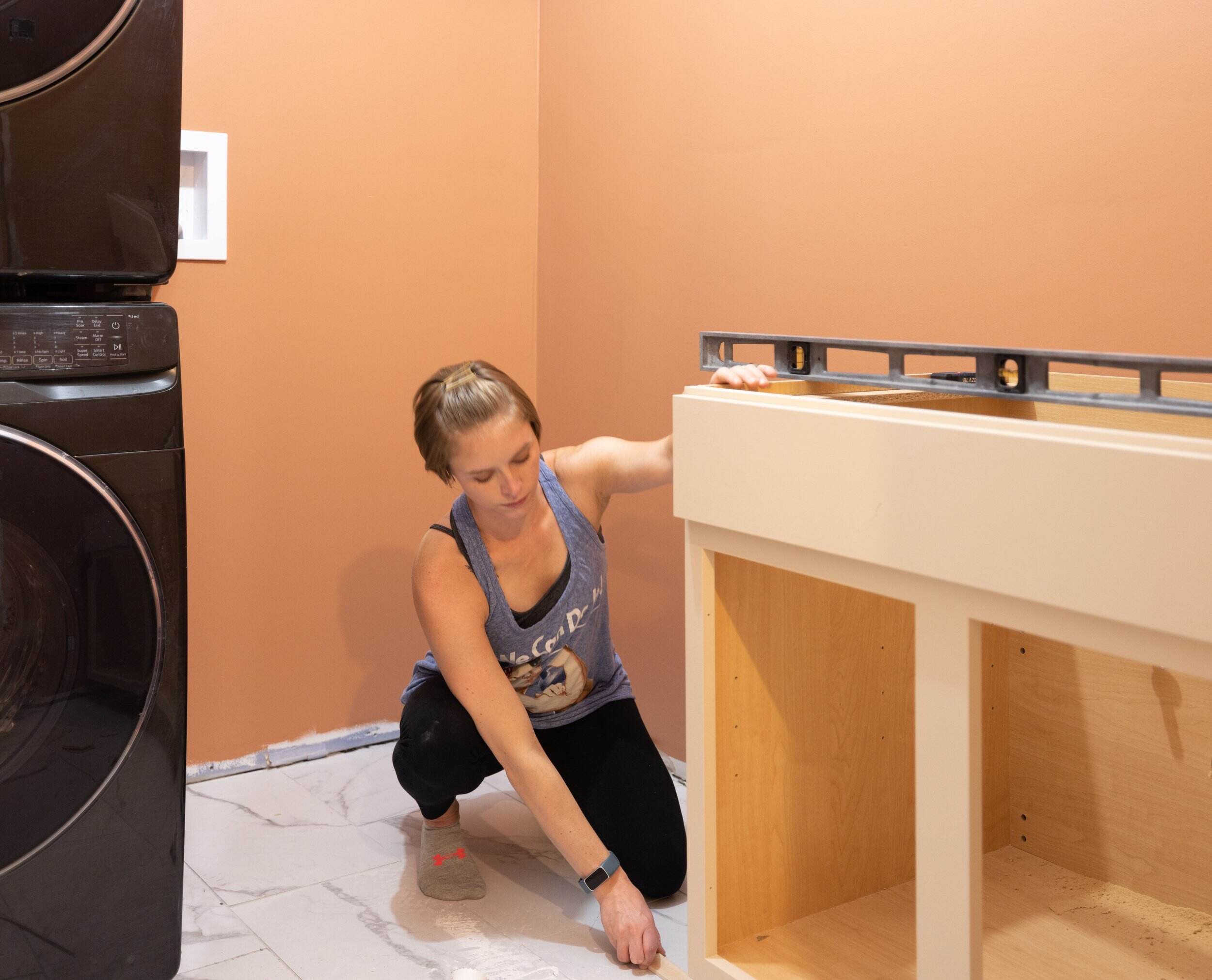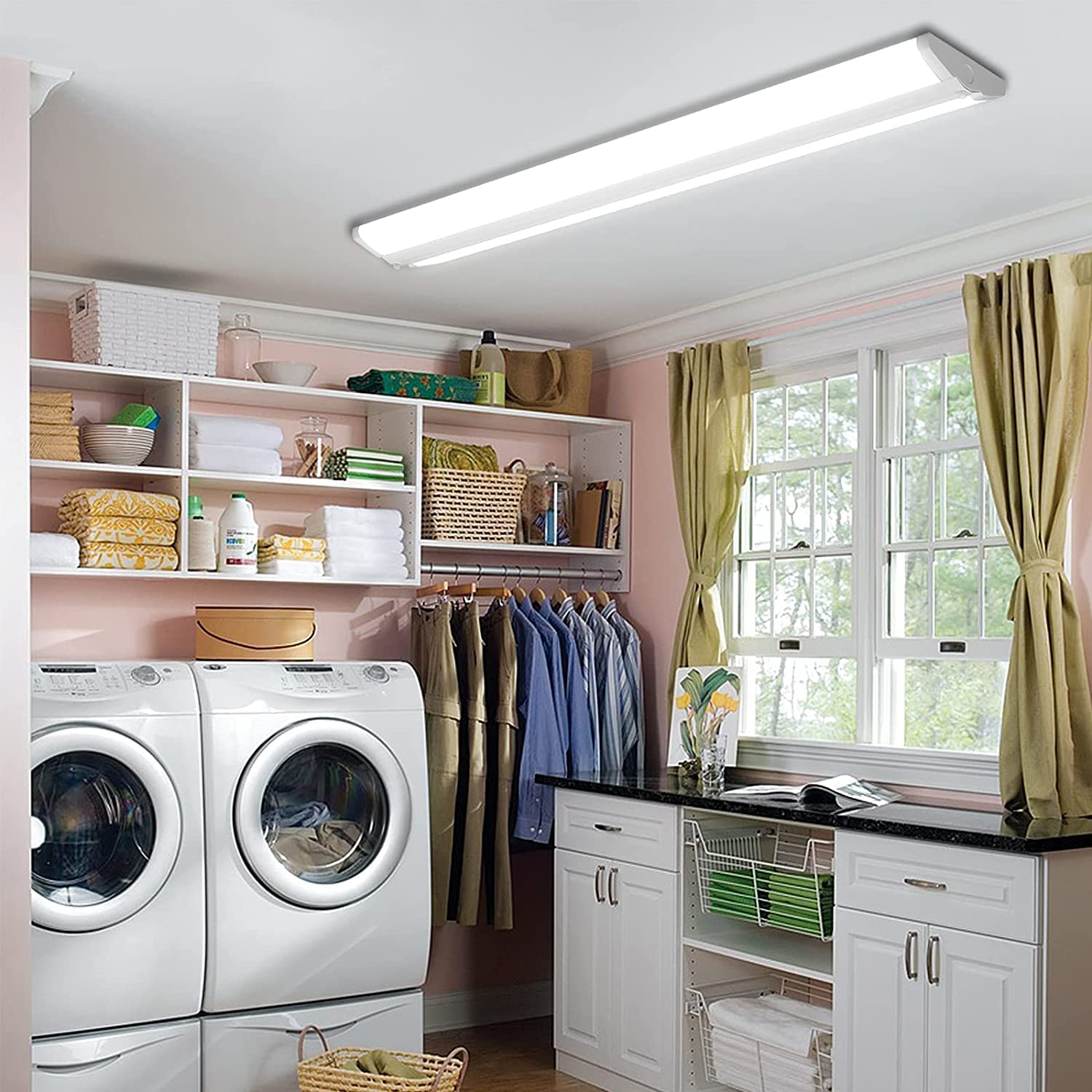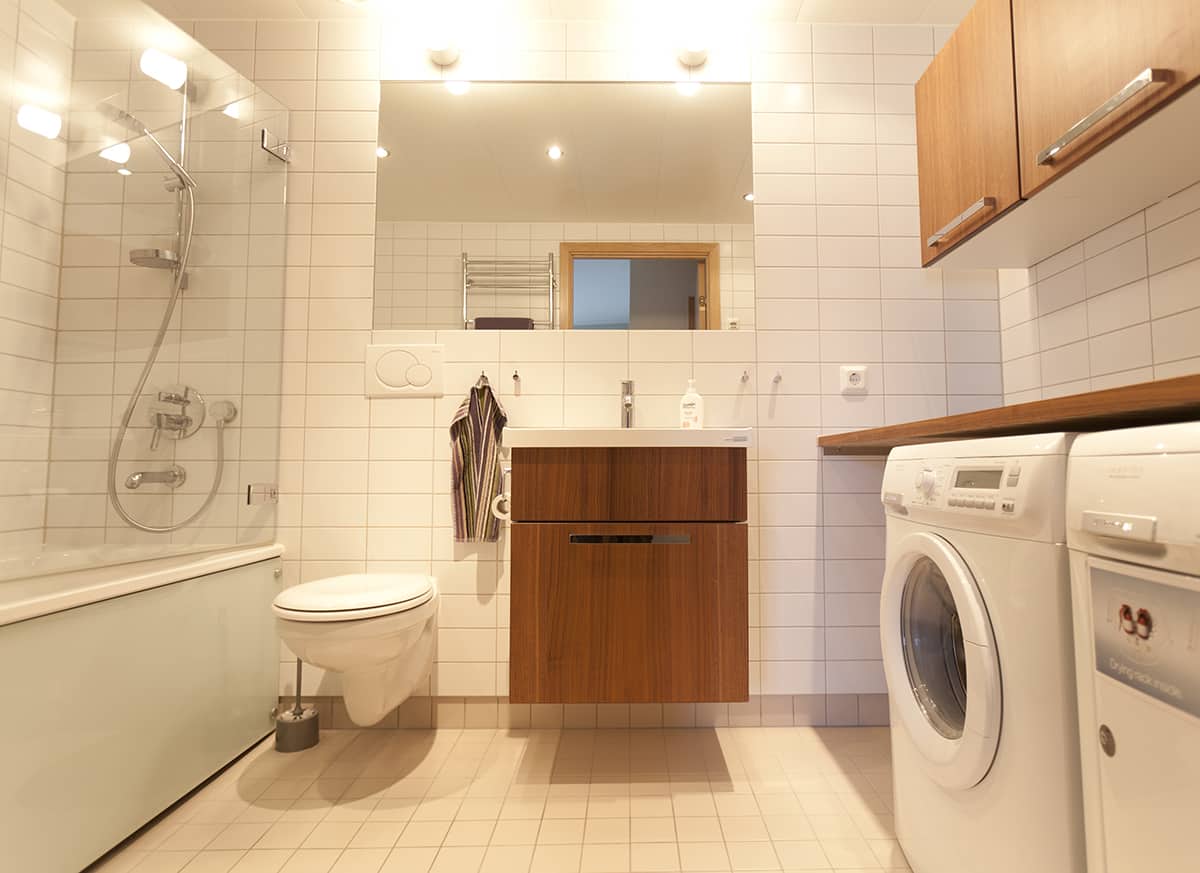

Articles
Why Is There A Fan In Laundry Room
Modified: October 30, 2024
Learn why having a fan in your laundry room is important for proper ventilation and preventing mold and mildew. Discover expert articles on laundry room fan installation and maintenance.
(Many of the links in this article redirect to a specific reviewed product. Your purchase of these products through affiliate links helps to generate commission for Storables.com, at no extra cost. Learn more)
Introduction
Welcome to your laundry room – a space dedicated to cleaning and caring for your clothes. While you may focus on the washing machine, dryer, and storage solutions, there is one often overlooked yet crucial element in a laundry room – ventilation and proper air circulation. One of the key components in achieving good ventilation is a fan.
A fan in the laundry room? You may be wondering why it is necessary. After all, it’s just a small room where you clean clothes, right? Well, think again. Laundry rooms are notorious for accumulating high levels of moisture and odors. Without proper ventilation, these factors can lead to a host of issues, including mold and mildew growth, unpleasant odors, and even potential health risks.
In this article, we will explore the importance of ventilation in laundry rooms, the reasons behind moisture and odor buildup, and the benefits of having a fan installed. We will also discuss the different types of fans available for laundry rooms, factors to consider when choosing one, and the installation process. Additionally, we will touch upon maintenance and troubleshooting common issues that may arise with laundry room fans.
By the end of this article, you will have a clear understanding of why having a fan in your laundry room is essential and how it can significantly improve the overall environment and functionality of the space.
Key Takeaways:
- Proper ventilation in the laundry room is crucial for preventing mold, mildew, and unpleasant odors. Installing a fan helps control moisture, eliminates odors, and improves air quality, creating a healthier and more pleasant laundry environment.
- When choosing a fan for your laundry room, consider factors such as room size, ventilation requirements, noise level, energy efficiency, aesthetics, and installation and maintenance requirements. Proper installation, regular maintenance, and prompt troubleshooting ensure optimal fan performance and longevity.
Importance of Ventilation in Laundry Rooms
Ventilation plays a critical role in maintaining a healthy and functional laundry room. The process of washing and drying clothes generates large amounts of moisture, which, if not properly eliminated, can create an environment conducive to mold and mildew growth. Additionally, the accumulation of odors from detergents, fabric softeners, and other laundry products can make the laundry room an unpleasant space to be in.
Proper ventilation helps to address these issues by removing excess moisture and odors, ensuring a clean and fresh environment. Here are a few key reasons why ventilation is important in laundry rooms:
- Mold and Mildew Prevention: Excessive moisture in a laundry room can lead to the growth of mold and mildew. These fungi thrive in damp environments and can cause a range of health issues, including allergies and respiratory problems. By installing a fan, you can effectively remove moisture from the air, reducing the risk of mold and mildew growth.
- Odor Elimination: The buildup of odors from laundry detergents, fabric softeners, and damp clothes can make the laundry room an unpleasant space. A fan helps to circulate fresh air, removing unwanted odors and keeping the room smelling clean.
- Improved Air Quality: Proper ventilation promotes better air quality in the laundry room by effectively removing airborne particles such as lint, dust, and allergens. This is especially important for individuals with allergies or respiratory conditions.
- Preventing Excessive Heat and Humidity: The dryer in the laundry room generates heat and releases moisture into the air. Without proper ventilation, this can lead to increased humidity levels and uncomfortable conditions. A fan helps to dissipate heat and reduce humidity, creating a more comfortable environment.
- Protecting the Structural Integrity of the Room: Excessive moisture in a laundry room can not only lead to mold and mildew issues but also cause damage to the walls, flooring, and other structural elements. Proper ventilation helps to prevent moisture damage, prolonging the lifespan of your laundry room.
By ensuring proper ventilation in your laundry room, you can create a healthier and more pleasant space to carry out your laundry tasks. A well-ventilated room not only protects your health but also helps to maintain the longevity of appliances and prevent potential costly repairs.
Understanding Moisture and Odor Buildup
In order to address the issue of moisture and odor buildup in the laundry room, it is important to understand the factors that contribute to their presence. By understanding these factors, you can take appropriate measures to prevent and mitigate the effects of excessive moisture and unpleasant odors.
Moisture Buildup
Moisture buildup in the laundry room can occur due to several reasons:
- Washing Machine: During the washing process, water is used to clean clothes. This water, along with residual moisture in the clothes, evaporates into the air in the laundry room.
- Dryer: The dryer in the laundry room releases moisture as it evaporates water from damp clothes. The exhaust vent of the dryer helps to expel this moisture, but without proper ventilation, it can linger in the room.
- Drying racks and hanging clothes: If you use drying racks or hang clothes to air dry in the laundry room, the evaporation process adds to the moisture levels in the room.
- Lack of airflow: Insufficient airflow in the laundry room can trap moisture, preventing it from dissipating naturally.
Odor Buildup
Odor buildup in the laundry room can be caused by various factors:
- Laundry products: The use of scented laundry detergents, fabric softeners, and other products can leave behind strong odors that can accumulate in the room.
- Damp clothes: If clothes are left sitting in the washing machine or dryer for extended periods, they can develop a musty smell that can permeate the room.
- Lint and dust: Lint and dust, which are common byproducts of laundry, can contribute to a stale and unpleasant odor if they are not properly removed.
- Mold and mildew: Excessive moisture can lead to the growth of mold and mildew, which produce a distinct, unpleasant odor.
Read more: Why Is My Laundry Room So Dusty
Combating Moisture and Odor Buildup
To combat moisture and odor buildup in the laundry room, proper ventilation is essential. A fan can help circulate the air, remove excess moisture and unpleasant odors, and ensure a fresh and clean environment. By expelling moisture and improving air circulation, a fan can prevent mold and mildew growth, eliminate musty smells, and keep the room dry and comfortable.
In the next sections, we will explore the benefits of having a fan in the laundry room and the different types of fans available to suit your needs.
Benefits of Having a Fan in the Laundry Room
Having a fan in your laundry room offers several benefits that positively impact the overall functionality and environment of the space. Let’s explore some of the key advantages:
1. Moisture Control
A fan aids in controlling moisture levels in the laundry room by efficiently removing excess humidity. This is especially important during the drying process when the dryer releases moisture into the air. By venting out the moist air, the fan helps to prevent the accumulation of moisture on surfaces, reducing the risk of mold and mildew growth. It also helps clothes dry faster, saving you time and energy.
2. Odor Elimination
The fan circulates fresh air, effectively eliminating unwanted odors that can develop in the laundry room. It helps to remove the smell of detergents, fabric softeners, and other laundry products, making the room more pleasant to be in. Additionally, by reducing moisture, the fan helps prevent musty odors that can arise from damp clothes or stagnant air.
Read more: Why Does Laundry Room Smell Like Sewer
3. Improved Air Quality
Proper ventilation provided by a fan helps to improve the overall air quality in the laundry room. It helps to remove airborne contaminants such as lint, dust, and allergens, reducing the risk of respiratory issues and allergies. With better air quality, you can breathe easier and enjoy a healthier environment.
4. Enhanced Drying Efficiency
By promoting air circulation, a fan facilitates faster drying of clothes. It helps to dissipate the moisture released by the washer and dryer, allowing for quicker evaporation. This not only saves time but also reduces the likelihood of clothes developing a musty smell from being left damp for extended periods.
5. Prevents Damage to Appliances and the Room
The moisture produced during laundry activities can be detrimental to appliances and the structural integrity of the laundry room. With proper ventilation provided by a fan, excess moisture is removed, protecting your appliances from damage and preventing potential costly repairs. Moreover, it helps to keep the walls, ceiling, and flooring dry, reducing the risk of mold growth and extending the lifespan of the room.
Overall, installing a fan in your laundry room offers numerous benefits, including moisture control, odor elimination, improved air quality, enhanced drying efficiency, and protection for your appliances and the room. The next section will delve into the different types of fans available for laundry rooms, helping you choose the most suitable option for your needs.
Different Types of Fans for Laundry Rooms
When it comes to selecting a fan for your laundry room, there are a few different types to consider. Each type has its own advantages, so you can choose the one that best meets your specific needs and preferences. Let’s explore some of the options:
Read more: What Is A Laundry Room
1. Ceiling Fans
Ceiling fans are a popular choice for many laundry rooms. They are mounted on the ceiling and provide excellent air circulation throughout the entire room. Ceiling fans come in various sizes and styles to suit different room dimensions and interior designs. They can help to distribute cool air in the summer months and recirculate warm air in the winter, making your laundry room comfortable year-round.
2. Wall-Mounted Fans
Wall-mounted fans are another option to consider for your laundry room. These fans are attached to the wall and can be positioned in a way that directs airflow in a specific direction. They are ideal for smaller laundry rooms or spaces with limited ceiling height. Wall-mounted fans are often adjustable, allowing you to control the speed and angle of airflow according to your preferences.
3. Window Fans
Window fans are a convenient choice for laundry rooms that have a window. These fans are designed to fit securely in a window frame, allowing for easy installation and removal. They can be positioned to pull fresh air into the room or exhaust stale air out, promoting effective ventilation. Window fans are often equipped with adjustable settings for airflow direction and speed.
4. Exhaust Fans
Exhaust fans are specifically designed to remove air from a room, making them an excellent option for laundry rooms. These fans are typically installed in the ceiling or wall and are connected to a vent that expels the air outside. Exhaust fans are highly efficient in removing moisture, odors, and airborne particles from the laundry room. They help maintain proper air quality and reduce the risk of mold and mildew growth.
5. Combination Fans/Lights
If you are looking for a multi-purpose solution, you may consider a combination fan and light fixture. These fans feature integrated lighting options, allowing you to illuminate your laundry room while enjoying the benefits of proper ventilation. Combination fans/lights come in various designs, including ceiling-mounted and wall-mounted options, to suit different room layouts.
When selecting the right fan for your laundry room, consider factors such as room size, installation requirements, noise level, and design. It’s also worth noting that some fans may require professional installation, especially for exhaust fans that require a vent to the outside.
Now that you are familiar with the different types of fans available, let’s explore the factors you should consider when choosing the best fan for your laundry room in the next section.
Factors to Consider When Choosing a Fan for Your Laundry Room
When selecting a fan for your laundry room, there are several important factors to consider. These factors will ensure that you choose the right fan that meets your specific needs and provides optimal ventilation. Here are some key considerations to keep in mind:
1. Room Size
Take into account the size of your laundry room when choosing a fan. Larger rooms may require a fan with higher airflow capacity to effectively circulate air throughout the space. On the other hand, smaller rooms may benefit from a smaller fan that doesn’t overpower the area. Consider the dimensions and layout of your laundry room to determine what size fan will provide adequate ventilation.
2. Ventilation Requirements
Assess the specific ventilation needs of your laundry room. If the room tends to accumulate a lot of moisture or odors, consider a fan with stronger airflow and ventilation capabilities. Exhaust fans are particularly effective for removing moisture and odors, while ceiling or wall-mounted fans provide general air circulation. Understand the ventilation requirements of your laundry room to choose the appropriate fan type.
Read more: Why Does Laundry Room Smell Like Rotten Eggs
3. Noise Level
Consider the noise level of the fan, especially if your laundry room is located near living spaces or bedrooms. Some fans can emit noise while operating, which can be disruptive. Look for fans that have a quiet or silent operation, ensuring that they do not disturb your daily activities or sleep. Pay attention to the decibel rating or noise level information provided by manufacturers.
4. Energy Efficiency
Energy efficiency is an important factor to consider when choosing a fan. Look for fans that are labeled as energy-efficient or have the Energy Star certification. These fans consume less energy while providing effective ventilation, helping you save on electricity bills. Energy-efficient fans are environmentally friendly and contribute to a greener home.
5. Aesthetics and Design
Take into account the aesthetics and design of the fan to ensure it complements the style of your laundry room. Fans are available in various styles, colors, and finishes, allowing you to choose one that matches your interior decor. Consider the shape and design of the fan, whether it is a ceiling fan, wall-mounted fan, or window fan, and select one that enhances the overall look of your laundry room.
6. Installation and Maintenance
Consider the installation and maintenance requirements of the fan. Some fans may require professional installation, while others are designed for simple DIY installation. Check for any specific maintenance instructions, such as filter replacements or cleaning requirements, to ensure you can easily maintain the fan’s functionality over time.
By considering these factors, you can make an informed decision when choosing a fan for your laundry room. The next section will guide you through the installation process of a laundry room fan, ensuring a smooth and hassle-free setup.
Read more: How To Clean A Laundry Room
Installation Process of a Laundry Room Fan
Installing a fan in your laundry room is a relatively straightforward process that can be accomplished with a few basic tools and some careful planning. Here is a general step-by-step guide to help you install a fan in your laundry room:
1. Choose the Location
Determine the ideal location for your fan. This will depend on the type of fan you have selected, such as a ceiling fan, wall-mounted fan, or window fan. Consider factors such as airflow direction, accessibility for wiring, and aesthetics.
2. Turn Off Power
Before starting the installation, turn off the power to the room at the circuit breaker to ensure your safety while working with electrical components. Use a voltage tester to double-check that the power is indeed off.
3. Prepare the Mounting Area
If you are installing a ceiling or wall-mounted fan, you may need to prepare the mounting area. Clear the space of any obstructions, and if necessary, make sure there is sufficient support for the fan. Follow the manufacturer’s guidelines for any specific instructions regarding the mounting surface.
Read more: How To Add A Laundry Room
4. Install Mounting Bracket
If you are installing a ceiling or wall-mounted fan, you will need to install the mounting bracket. Use a screwdriver to secure the bracket in place, ensuring it is stable and properly aligned.
5. Wire the Fan
If your fan requires electrical wiring, carefully follow the instructions provided by the manufacturer to connect the wires. This may involve connecting the wires from the fan to the existing electrical connections in the room, or it may require additional wiring if there is no existing electrical outlet. If you are not familiar with electrical work, it’s advisable to consult a professional electrician for safety.
6. Secure the Fan
Once the wiring is complete, carefully attach the fan to the mounting bracket. Ensure that all screws and attachments are properly tightened to secure the fan in place.
7. Test the Fan
Before restoring power to the room, test the fan to ensure it is functioning correctly. Turn on the fan and check for any unusual noises or issues with the airflow. If everything is working properly, proceed to the next step.
Read more: How To Finish Laundry Room
8. Restore Power and Enjoy
Finally, restore power to the room by turning on the circuit breaker. With the fan properly installed and connected, you can now enjoy the benefits of improved ventilation and air circulation in your laundry room.
Keep in mind that the installation process may vary depending on the type and model of the fan you choose, as well as the specific requirements of your laundry room. Always refer to the manufacturer’s instructions and, if necessary, consult a professional for guidance.
Now that your fan is installed, it is important to know how to properly maintain and care for it. The next section will provide tips on maintaining and troubleshooting common issues with laundry room fans.
Maintenance and Care for a Laundry Room Fan
Proper maintenance and care are essential for ensuring the longevity and optimal performance of your laundry room fan. By following a regular maintenance routine, you can keep the fan running efficiently and prevent potential issues. Here are some important tips for maintaining and caring for your laundry room fan:
1. Regular Cleaning
Regularly clean your fan to remove dust, lint, and other debris that can accumulate over time. Dust and debris can impede the airflow and affect the fan’s performance. Use a soft cloth or brush to gently wipe the fan blades, motor housing, and other accessible parts. Avoid using harsh chemicals or abrasive materials that can damage the fan.
2. Check and Replace Filters
If your fan has a filter, check it regularly and clean or replace it as necessary. Filters help to trap airborne particles and keep the air clean. Depending on the type of fan, the filter may be washable or disposable. Follow the manufacturer’s instructions for proper filter maintenance.
Read more: How To Soundproof Laundry Room
3. Lubricate Moving Parts
If your fan has moving parts, such as bearings or motor mechanisms, lubricate them as recommended by the manufacturer. Lubrication helps to reduce friction and keep the fan operating smoothly. Use the appropriate lubricant specified for your fan type and apply it according to the manufacturer’s instructions.
4. Inspect and Tighten Connections
Regularly inspect the fan’s connections, such as screws, bolts, and wiring. Ensure that everything is secure and tightened properly. Loose connections can cause vibrations or even pose safety hazards. If you notice any loose components, tighten them immediately or consult a professional if necessary.
5. Monitor Noise and Performance
Pay attention to any unusual noises or changes in the fan’s performance. Grinding or rattling sounds can indicate a problem with the fan’s motor or other internal components. If you notice any issues, it’s advisable to have the fan inspected and serviced by a professional to prevent further damage.
6. Keep Surrounding Area Clear
Ensure that the area around the fan is clear of any obstructions. Remove any objects or debris that may interfere with the fan’s airflow. This will help the fan operate efficiently and prevent overheating.
7. Schedule Professional Maintenance
Consider scheduling regular professional maintenance for your fan. A professional technician can inspect and service the fan, identify any potential issues, and ensure that it is working at its best. They can also perform any necessary repairs or adjustments to keep the fan in optimal condition.
By following these maintenance tips and caring for your laundry room fan, you can extend its lifespan, maintain optimal performance, and enjoy clean and efficient ventilation in your laundry room.
However, even with proper maintenance, issues can still arise. In the next section, we will discuss some common troubleshooting tips for addressing common problems with laundry room fans.
Troubleshooting Common Issues with Laundry Room Fans
Laundry room fans, like any other mechanical device, can sometimes experience problems that affect their performance. Understanding the common issues that may arise and knowing how to troubleshoot them can help you resolve the problem quickly and efficiently. Here are some common issues with laundry room fans and their possible solutions:
1. Fan Not Turning On
If your laundry room fan fails to turn on, there are a few potential causes to investigate:
- Check the power supply. Ensure that the fan is securely plugged in, and there is power to the outlet it is connected to.
- If the fan is activated by a switch, check if the switch is functioning properly. Replace it if necessary.
- Inspect the fan’s wiring for any loose connections or damages. Consult a professional electrician if you are uncertain or uncomfortable working with electrical components.
2. Weak Airflow
If your fan is running but producing weak airflow, consider the following solutions:
- Check for any obstructions in the fan, such as dust, lint, or debris. Clean the fan blades, motor housing, and vents to remove any blockages that may be impeding the airflow.
- Inspect the fan’s filter, if applicable. Clean or replace the filter as necessary to ensure unrestricted airflow.
- Check the fan’s speed settings. Ensure it is set to the desired speed and adjust it if needed.
Read more: How Big Should A Laundry Room Be
3. Excessive Noise
If your fan is making excessive noise, try these troubleshooting steps:
- Inspect the fan blades for any visible damage or debris. Clean the blades and remove any foreign objects that may be causing the noise.
- Tighten any loose screws or bolts that connect the fan components. Loose fittings can cause vibrations and noise.
- If the noise persists, it may indicate a problem with the fan’s motor or other internal components. In such cases, it is recommended to consult a professional technician for further inspection and repair.
4. Fan Overheating
If your fan is overheating, take the following steps to address the issue:
- Ensure that the fan is not obstructed by any objects or debris that may impede proper airflow. Clear the area around the fan and ensure there is adequate ventilation.
- Verify that the fan motor is not overloaded. If the fan is running continuously or at high speeds for extended periods, it may overheat. Allow the fan to rest and cool down before using it again.
- Consider adjusting the fan’s speed settings to reduce the workload on the motor and minimize the risk of overheating.
If you encounter more complex or persistent issues with your laundry room fan, it is recommended to contact a professional technician or the manufacturer’s customer support for further assistance. They will have the expertise to diagnose and resolve the problem effectively.
By troubleshooting common issues and addressing them promptly, you can maintain the functionality and efficiency of your laundry room fan, ensuring optimal ventilation in this essential space.
With the troubleshooting covered, we have explored the importance of ventilation in laundry rooms, the reasons behind moisture and odor buildup, the benefits of having a fan installed, different types of fans available, factors to consider when choosing a fan, the installation process, and maintenance tips. By following these guidelines, you can create a well-ventilated and pleasant laundry room that enhances your laundry experience.+
Remember, regular maintenance and care for your laundry room fan are essential to keep it running smoothly. Don’t hesitate to seek professional assistance if needed. Enjoy the benefits of a well-ventilated laundry room and fresh, clean air!
Conclusion
Having a fan in your laundry room can make a significant difference in the overall functionality and environment of the space. Proper ventilation is essential to control moisture levels, prevent odor buildup, and improve air quality. By installing a fan, you can enjoy a laundry room that is free from mold, mildew, and unpleasant smells.
Throughout this article, we have explored the importance of ventilation in the laundry room and the reasons behind moisture and odor buildup. We have discussed the benefits of having a fan installed, including moisture control, odor elimination, improved air quality, enhanced drying efficiency, and protection for appliances and the room structure.
Additionally, we have looked at the different types of fans available for laundry rooms, such as ceiling fans, wall-mounted fans, window fans, exhaust fans, and combination fans/lights. Each type offers unique features and advantages, allowing you to choose the one that best suits your specific needs and preferences.
When choosing a fan, it is important to consider factors such as room size, ventilation requirements, noise level, energy efficiency, aesthetics, and installation and maintenance requirements. This ensures that you select a fan that meets your requirements and integrates seamlessly into your laundry room.
The installation process for a laundry room fan involves choosing the ideal location, turning off power, preparing the mounting area, installing the mounting bracket, wiring the fan, securing it in place, and testing the fan’s functionality. Following these steps and any specific instructions provided by the manufacturer will help ensure a successful installation.
To keep your laundry room fan running smoothly, regular maintenance and care are necessary. This includes cleaning the fan, checking and replacing filters, lubricating moving parts, inspecting and tightening connections, keeping the surrounding area clear, and scheduling professional maintenance as needed. These practices will prolong the life of your fan and maintain its optimal performance.
In the event of common issues with your laundry room fan, it’s important to troubleshoot and address them promptly. By following the troubleshooting tips provided, you can resolve issues like the fan not turning on, weak airflow, excessive noise, and overheating, ensuring that your fan operates efficiently and effectively.
In conclusion, a well-ventilated laundry room with a properly installed and maintained fan provides benefits that go beyond just clean clothes. It promotes a healthier environment, prevents damage to appliances and the room, and creates a more pleasant space for your laundry tasks. Embrace the power of ventilation and enjoy the benefits of a well-ventilated and fresh-smelling laundry room!
Frequently Asked Questions about Why Is There A Fan In Laundry Room
Was this page helpful?
At Storables.com, we guarantee accurate and reliable information. Our content, validated by Expert Board Contributors, is crafted following stringent Editorial Policies. We're committed to providing you with well-researched, expert-backed insights for all your informational needs.





0 thoughts on “Why Is There A Fan In Laundry Room”